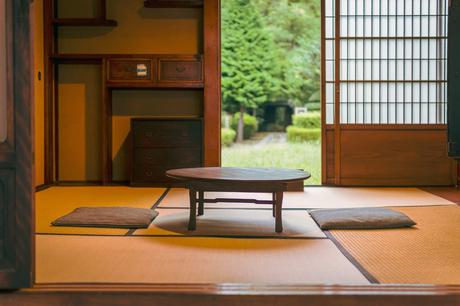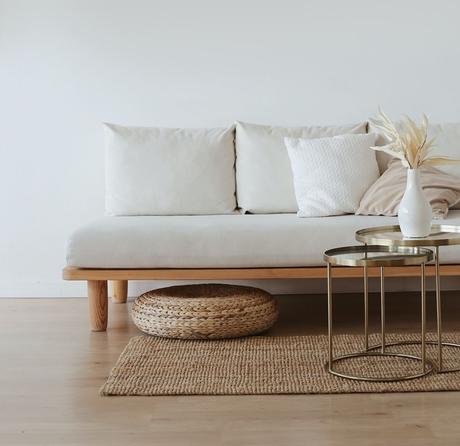Designing the perfect living room comes with complex arrangements and investments. In the end, all efforts are worth it because the living room is where we spend most of our time, alone or with loved ones. It's the room where we feel at ease after a hectic day at work, so it's necessary to invite us in any time we need to recharge our batteries.
So, today we approach the Japanese way of decorating a room because its elements and tradition are made to enhance the feeling of "Zen." Japanese room décor has certain principles that aim to blend functionality, nature and minimalism to reach simple characteristics.
Your living room doesn't have to be perfect, per the Wabi Sabi principle. This means you can embrace imperfection as it's a part of our surroundings, and beauty can find its way even among rusticity.

Photo credit: Unsplash
Numerous papers and researchers proved the link between staying connected to nature and improved mental health. But when natural elements are lacking in our environments, we can bring them inside with decorative pieces and plants.
Japanese décor style suggests that we choose earthy tones, such as brown, grey or green, in our living rooms to make them look balanced and natural. Neutral tones should lead the color palette, while natural tones, such as green, can be used as an accent color to make the room livelier. Alternatively, you can fill the living room with massive plants by painting the room with green accents or having green objects around it.
While Japanese-styled living rooms have mostly wood incorporated around elements like chairs, lamp stands, and tables, you can mix and match wood and textiles to make the place look fresh.
Although these materials might require more care and attention, they will last for a long time, as quality is always essential for Japanese designs.
If you're searching for qualitative textiles, you can look into what is oeko tex and its standards. Fabrics labeled with Standard 100 show that products are free of harmful substances and have been made by transparent suppliers prioritizing sustainability. You can also look into the GRS or OCS standards to learn more about specific textile compositions.
Japanese people are used to having low furniture as they feel most comfortable sitting on the floor. In such a room, you'll see tatami mats, which are placed on the floor to make it easier to sit down. These products are also used to regulate temperatures and humidity in the room so the living room doesn't risk developing mold or being too cold during winter.
Sitting on the floor also requires cushions (zabuton) to make it comfortable to sit down longer. These products are not regular throw pillows as they're thick and firm to support your back and feet. You can choose a bolder color for these cushions to make them pop up when entering the room.
If you're courageous enough, adding a lowered table in the middle of the room will contribute to the Japanese décor. In most households, these tables have a blanket attached so you can stay cozy while eating or watching TV.
Although this is a praised concept all over the décor blogs, the Japanese way differs. That's because their large windows and sliding doors made with translucent paper and wood bring more natural light in with no significant effort. Of course, regular Western houses are designed in a particular way, so adding sliding doors might be more challenging.
However, expanding the space available for bigger windows is paramount to allowing natural light inside because it benefits our health. Sunlight increases vitamin D intake, improves sleep and makes us happier.
Circular designs tend to represent Zen, characterized by ensō, a circular drawing that outlines strength and elegance through minimalism. So, choosing circular-based decorations around the house is an excellent idea if you want to emerge within the culture.
If you're creative enough, anything can have this form, from mirrors to windows and shelves. Luckily, the market is packed with these designs in multiple objects for home decorations, so you can easily introduce this concept within your house. Besides, the circular design is pretty popular now as it looks neater, so you won't be out of style.

Photo credit: Pexels
Japanese design culture is known as minimalist, but so does Scandinavian décor principles. In an attempt to create something unique, these practices merged, creating Japandi, a beautifully minimalist and stylish concept that approaches elements from both trends.
Japandi design focuses on muted colors and clear lines but exceptional furnishings. The Japanese part of the decoration concept states that qualitative and handmade craftsmanship is better than any structure. In contrast, the Scandinavian part contributes to the notion of hygge, which translates to coziness.
Decorating in the Japandi style is an interesting approach to making your living room the perfect space. You can play with the designs, but it's best to introduce natural materials like wood and bamboo to add a pinch of simplicity and style to the room. Colors should be muted, while plants are necessary for the room to have a sense of outdoor living.
But the most essential aspect of Japandi is reducing clutter. So, keep the things you need within reach, but make sure you're not keeping poorly maintained objects, which only make your space smaller. If you don't like minimalism, you can approach "faux minimalism," in which you simply hide your things around the house in boxes and baskets to make the living room cleaner and more open.
Japanese décor style might seem boring at first, but it's one of these things that simply bring light and peace into your house; by introducing elements of simplicity and nature, your living room will become your favorite place to hang around, and keeping it neat and clean will be easy with Japanese designs.
